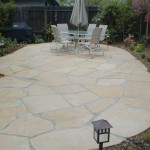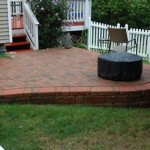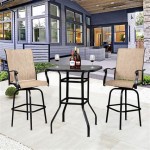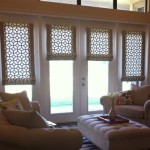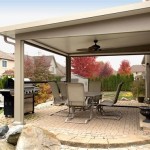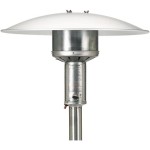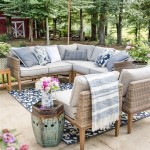Stone Patio Ideas With Fire Pit: A Comprehensive Guide
A stone patio with a fire pit serves as an attractive and functional outdoor living space, offering homeowners a gathering point for relaxation, entertainment, and warmth. The combination of natural stone and the inviting glow of a fire creates an ambiance that extends the usability of a backyard well into the cooler months. The process of designing and implementing such a project involves careful consideration of various factors, including materials, layout, safety regulations, and overall aesthetic harmony.
The selection of appropriate stone is paramount. Various types of stone are available, each possessing unique characteristics regarding durability, color, texture, and cost. Options range from natural stone like flagstone, slate, and travertine to manufactured pavers designed to mimic the appearance of natural stone. Understanding the properties of each material and how they will withstand local climate conditions is crucial for long-term satisfaction.
The fire pit itself also requires meticulous planning. Choices include wood-burning, propane, or natural gas-fueled fire pits. Each type has distinct advantages and disadvantages concerning fuel availability, ease of use, and environmental impact. Building codes and safety regulations must be strictly adhered to during installation, particularly regarding clearance distances from structures and combustible materials. The fire pit's design should complement the patio's overall aesthetic while providing ample seating and a comfortable gathering area.
Choosing the Right Stone for Your Patio
The material selected for a stone patio heavily influences its appearance, durability, and maintenance requirements. Natural stone provides a distinctive, organic aesthetic, with each piece exhibiting unique variations in color and texture. Flagstone, a popular choice, is relatively easy to work with and offers a range of colors, from earthy browns and reds to cooler grays and blues. Slate, known for its smooth, layered surface, provides a more formal and refined look. Travertine, with its porous texture and warm tones, offers a classic, Mediterranean feel.
Manufactured pavers, often made from concrete, offer a cost-effective alternative to natural stone. They are available in a wide array of styles, colors, and sizes, often mimicking the appearance of natural stone. Pavers are typically more uniform in size and shape, simplifying installation and creating a more consistent aesthetic. They also tend to be more resistant to staining and fading than some natural stone options. However, some argue that they lack the inherent character and uniqueness of natural stone.
Beyond aesthetics, consideration should be given to the stone's durability and porosity. Porous stones, like some types of sandstone, may require sealing to prevent water absorption and staining. The stone's ability to withstand freezing temperatures and thawing cycles is also critical in climates with harsh winters. Selecting a stone that is naturally slip-resistant, or applying a slip-resistant sealant, is important for safety, particularly in areas prone to moisture.
Cost is an inevitable factor in the decision-making process. Natural stone tends to be more expensive than manufactured pavers, both in terms of the material itself and the labor required for installation. The complexity of the patio's design, the size of the area, and the accessibility of the location will all influence the overall cost. Obtaining multiple quotes from reputable contractors is highly recommended to ensure a fair price and to assess the contractor's experience and expertise.
Fire Pit Options and Safety Considerations
The selection of a fire pit design is a critical element in completing a stone patio. It involves not only the aesthetics of the fire pit itself but also functional and safety concerns. Each type of fuel source – wood, propane, and natural gas – offers different benefits and drawbacks.
Wood-burning fire pits provide the classic ambiance of a crackling fire, with the scent of burning wood adding to the atmosphere. They are often the most affordable option upfront, but require a readily available source of firewood. Wood-burning fire pits produce smoke and embers, which may be a concern for neighbors and require careful attention to prevent fire hazards. Local regulations often restrict the use of wood-burning fire pits during certain times of the year, particularly in areas prone to wildfires.
Propane fire pits offer a convenient alternative to wood-burning fire pits. They are easy to light and extinguish, and produce significantly less smoke and embers. Propane fire pits require a propane tank, which can be either hidden within the fire pit structure or connected via a hose. While propane is readily available, the cost of refilling propane tanks can add up over time. Always store extra propane tanks safely and away from potential heat sources.
Natural gas fire pits provide the ultimate in convenience, as they are connected directly to a home's natural gas line. They offer a consistent and reliable fuel source, eliminating the need to purchase or refill propane tanks. However, installing a natural gas fire pit requires professional installation by a licensed plumber or gas fitter, adding to the initial cost. Natural gas fire pits also require a permanent connection to the gas line, limiting their portability.
Regardless of the fuel source selected, safety should be the top priority. Ensure compliance with all local building codes and regulations, including setback distances from structures, property lines, and combustible materials. Install a spark screen or fire pit cover to prevent embers from escaping. Keep a fire extinguisher or water hose readily available in case of emergencies. Never leave a fire unattended, and ensure that it is completely extinguished before leaving the area. Educate all family members and guests on fire safety procedures.
Integrating the Fire Pit and Patio Design
The seamless integration of the fire pit and patio design is paramount for creating a cohesive and aesthetically pleasing outdoor living space. The layout, materials, and landscaping should all work together to create a comfortable and inviting atmosphere. Careful consideration should be given to the size and shape of the patio, the placement of the fire pit, and the arrangement of seating and other outdoor furniture.
The size of the patio should be proportionate to the size of the fire pit and the number of people it is intended to accommodate. A small fire pit may be suitable for a cozy patio designed for intimate gatherings, while a larger fire pit may be necessary for a spacious patio intended for entertaining larger groups. Ensure ample space for seating around the fire pit, as well as comfortable walkways and circulation areas.
The placement of the fire pit can significantly impact the overall flow and functionality of the patio. A central location creates a focal point and encourages conversation, while a corner placement can maximize space and provide a more intimate setting. Consider the prevailing wind direction when positioning the fire pit to minimize smoke exposure for guests. Avoid placing the fire pit too close to structures, trees, or other combustible materials.
The selection of outdoor furniture and accessories should complement the style and color palette of the stone patio and fire pit. Comfortable seating, such as Adirondack chairs, rocking chairs, or outdoor sofas, is essential for creating a relaxing and inviting atmosphere. Consider adding outdoor lighting to enhance the ambiance and functionality of the patio, particularly during the evening hours. String lights, lanterns, or spotlights can be used to create a warm and inviting glow. Planters, potted plants, and other landscaping elements can add color, texture, and visual interest to the patio area, creating a more natural and inviting environment.
Ultimately, the goal is to create an outdoor living space that is not only visually appealing but also functional, safe, and enjoyable for years to come. By carefully considering the various factors involved in designing and installing a stone patio with a fire pit, homeowners can create a backyard oasis that enhances their lifestyle and adds value to their property.

Best Fire Pit Ideas Heated Backyard Retreat Designs Natural Brick Stone Depot

60 Backyard And Patio Fire Pit Ideas Diffe Types With Photo Examples Landscaping Outdoor Designs

12 Best Outdoor Fire Pit Ideas Diy Backyard

Fire Pit Ideas You Ll Love Lazo Landscaping

Stone Fire Pits Harford Baltimore County Md Pit Patio Backyard Diy

40 Best Flagstone Patio Ideas With Fire Pit Hardscape Designs

Planning For A Paver Patio Ideas And Inspiration Town Country Living

Fire Pit Landscaping Ideas Town Country Living

30 Best Stone Patio Ideas For Your Outdoor In Backyard Browse A Lot Of Photos Fi Seating Area

12 Best Outdoor Fire Pit Ideas Diy Backyard
Related Posts

